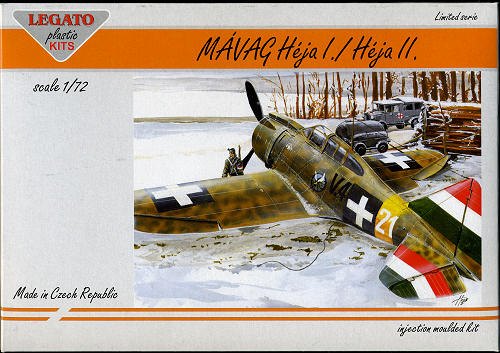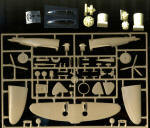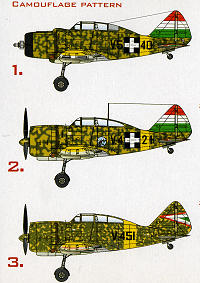
Legato 1/72 MAVAG Heja I/II
| KIT #: | 72003 |
| PRICE: | $26.05 from www.greatmodels.com |
| DECALS: | Three Options |
| REVIEWER: | Scott Van Aken |
| NOTES: | Short run kit with resin and photo etch parts as well as vacuformed canopies |

| HISTORY |
In December 1939, Hungary purchased 70 Reggiane Re.2000 fighters from Italy. They were delivered to the Hungarian firm Magyar Királyi Állami Vas-, Acél- és Gépgyárak (Royal Hungarian State Iron, Steel and Machine Works) and were modified into the MÁVAG Héja I (Goshawk I). The original Piaggio P.XI engines were replaced by the Hungarian-built Manfred Weiss WM K-14 that drove a Hamilton Standard three-bladed, constant-speed propeller. The WM K-14 was a licensed copy of the French Gnome-Rhône 14K engine that necessitated a 1-foot 3-inch lengthening of the fighters’ forward fuselage, due to a shift in the center of gravity from the lighter engine. Oddly enough, the Piaggio engine was itself a copy of the Gnome-Rhône 14K, but it wasn't as reliable as the original.
A decision was soon made to produce more Héja fighters under licenses in Hungary as the MÁVAG Héja II (Goshawk II). The new Héja II was entirely Hungarian with locally produced airframes, engines and armament. The new fighter differed from the Reggiane fighter in a number of ways. Armament was changed to 2 × 0.50 inch (12.7 mm) Gebauer fixed forward-firing guns in the upper nose with 300 rounds each. Length was 27 ft 6.25 inch (8.39 m), and max level speed was 301 mph (485 km/h) at 13,780 ft (4,200 m). Endurance was 2 hours and 30 minutes. The first MÁVAG Héja II took to the air on October 30, 1942, and in total MÁVAG built a further 203 Héja's for the Royal Hungarian Air Force. The last machine was completed on August 1, 1944 when production ceased.
The Kingdom of Hungary was allied to Nazi Germany during World war II. At least one Hungarian squadron flew the MÁVAG Héja I/II in combat on the Eastern Front. However, most Héja's operated inside Hungary in an air defense role or as a trainer.
In September 1942, personal tragedy struck the Hungarian Regent Miklós Horthy. 37-year-old István Horthy, Horthy's eldest son, was killed. István Horthy was the Deputy Regent of Hungary and a Flight Lieutenant in the reserves, 1/1 Fighter Squadron of the Royal Hungarian Air Force. He was killed when his Héja fighter signed "V.421" crashed at an air field near Ilovskoye.
| THE KIT |
 My
lone experience with Legato was not a good one as I suffered through the
horrendous fit of their all resin FW-190v1, only to give up a few years ago. It
is now in a box on the shelf of shame, that includes a number of other
unfinished kits.
My
lone experience with Legato was not a good one as I suffered through the
horrendous fit of their all resin FW-190v1, only to give up a few years ago. It
is now in a box on the shelf of shame, that includes a number of other
unfinished kits.
However, that was then and this is now that we have a limited run injection molded kit of the Hungarian Re.2000. I noticed that several other boxings of this kit have been produced by Legato to extend the use of the molds. Overall, the injected pieces are fairly well done. The engravings are well done and while not as fine or petite as with some others, painting should attenuate their impact. The plastic has a somewhat rough feeling to it and I noticed that the mold seams were a bit more than one would find with a standard injected kit. Nothing unusual for a short run kit.
All of the injected parts are on a single spure and I found it a bit unusual that the fin was a separate item. Normally it is molded in one or both of the fuselage halves to help eliminate problems with alignment. I also noticed that one of the props was missing a blade. It was found in the bag once the parts were all removed. There are inserts for the main wheel wells to provide depth. The cockpit is quite basic with little more than a floor seat and stick. The instrument panel has a photo etch front and acetate instruments. Photo etch is also used for catapult attachment points and hold down points, items not used in this boxing. Two vacuformed canopies are provided, one for the Heja I and one for the Heja II as they are a bit different. Molding is OK, but not great as there are some dimples on the top of the canopy that will need filled.
 The major
difference between the two aircraft is the engine and cowling. These are
provided in resin and are quite well cast. Though one probably won't see the
rear bank of cylinders on the engine, it is nice that these have been provided.
To build the Heja II, one will have to do some carving on the fuselage.
The major
difference between the two aircraft is the engine and cowling. These are
provided in resin and are quite well cast. Though one probably won't see the
rear bank of cylinders on the engine, it is nice that these have been provided.
To build the Heja II, one will have to do some carving on the fuselage.
 Instructions
are fairly well done and it is obvious that some of the construction drawings
were used from other kits as a few steps are X'd out. The builder will have to
stretch some sprue for the guns or use some thinwall tubing. Markings are
provided for three planes. One is the Heja II from 1944 with the later insignia.
Two is a Heja I from the summer of 1942. Three is another Heja I from earlier in
1942 with the earlier insignia. All three of them are similarly painted with a
tan base and dense green squiggles over the upper surface. Underside of the
wings and a band around the fuselage are in yellow as was the norm for Axis
planes on the Eastern Front. A full color painting guide is on the back of the
box though there is no upper wing or tail scheme. One can, however, use the box
art to help out. The decals look to be very nicely printed and should work well.
Instructions
are fairly well done and it is obvious that some of the construction drawings
were used from other kits as a few steps are X'd out. The builder will have to
stretch some sprue for the guns or use some thinwall tubing. Markings are
provided for three planes. One is the Heja II from 1944 with the later insignia.
Two is a Heja I from the summer of 1942. Three is another Heja I from earlier in
1942 with the earlier insignia. All three of them are similarly painted with a
tan base and dense green squiggles over the upper surface. Underside of the
wings and a band around the fuselage are in yellow as was the norm for Axis
planes on the Eastern Front. A full color painting guide is on the back of the
box though there is no upper wing or tail scheme. One can, however, use the box
art to help out. The decals look to be very nicely printed and should work well.
Late note: I should have caught this, but missed it. The early markings for the horizontal stabilizer is in the wrong order. Red should be near the fin as shown in the box art. Means you'll have to paint this if doing the early scheme. The green in the box art is also too dark.
| CONCLUSIONS |
Though perhaps not everyone's cup of tea, the Heja was an important fighter in the Hungarian Air Force and the largest export order for any of the Reggianne fighters. Thanks to the interesting camo scheme, it should turn into a very nice model with a bit of care in construction.
| REFERENCES |
http://en.wikipedia.org
May 2010
You can get this as well as other fine kits and accessories at
GreatModels
If you would like your product reviewed fairly and quickly , please
contact
me or see other details in the
Note to
Contributors.